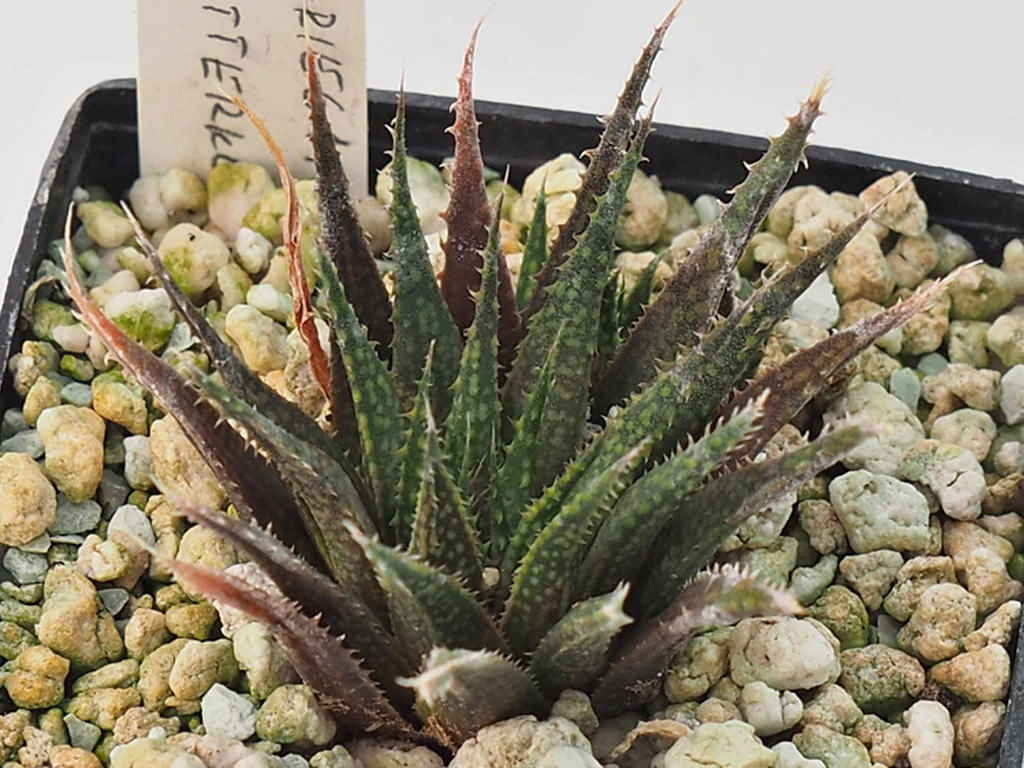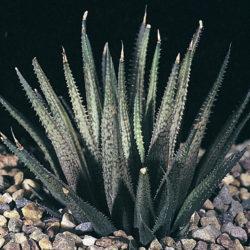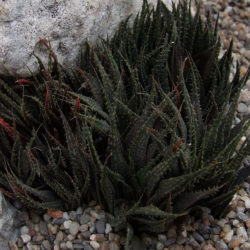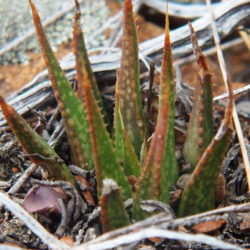Scientific Name
Haworthia variegata L.Bolus
Synonym(s)
Haworthia chloracantha subsp. variegata, Haworthia chloracantha var. variegata, Haworthia variegata var. variegata
Scientific Classification
Family: Asphodelaceae
Subfamily: Asphodeloideae
Tribe: Aloeae
Genus: Haworthia
Origin
This species is native to South Africa. It occurs only in an area between Riversdale and Stilbaai in Western Cape, where it grows mainly in rock crevices or on flat sandy soil.
Description
Haworthia variegata is a small succulent that forms stemless rosettes of slender dark green leaves with numerous translucent lines and flecks. The rosettes grow up to 2.8 inches (7 cm) in diameter, producing offsets from the base to form a clump. Leaves are erect to spreading, lance-shaped, up to 2.2 inches (5.5 cm) long and 0.3 inches (0.7 cm) wide. They are smooth with spined margins and keel. Flowers are white with brownish venation and appear on slender, unbranched, up to 14 inches (35 cm) long stalks.
Etymology
The specific epithet "variegata (var-ee-GAY-tuh)" is the feminine form of "variegatus," meaning "variegated" or "having a pattern of different colors or marks" and refers to the variegated leaves.

How to Grow and Care for Haworthia variegata
Light: Place the potted plant in a bright area with some protection from the hottest rays of the day. White, yellow, or red-tinged leaves usually indicate that your H. variegata is receiving too much sunlight. Deep shade tends to weaken the plant over a prolonged period. If your plant has spent the winter indoors, gradually move it outdoors into the bright sun to prevent sunburn.
Soil: Like all Haworthias, this plant does not like its roots to remain wet for prolonged periods, so the soil should be well-drained. Use a commercial potting mix for succulents or make your own.
Hardiness: This succulent likes warmer temperatures in the summer but cool in the winter. However, it does not like being too cold. H. variegata can withstand temperatures as low as 30 to 50 °F (-1.1 to 10 °C), USDA hardiness zones 10a to 11b.
Watering: In spring and fall, when the growth is most active, water H. variegata thoroughly, then wait until the top of the soil dries out before watering again. Water your plant less during the winter when its growth slows down significantly. During the hottest summer months, when this plant is mostly dormant, water just enough to keep the leaves from shriveling.
Fertilizing: H. variegata does not require much fertilizer. However, for optimum growth, fertilizing is a good idea. Feed only with a dilute fertilizer and only during the active growing season.
Repotting: This slow-growing succulent can stay in the same pot for years. To keep your plant healthy and happy, repot H. variegata into fresh soil every two to three years in spring or fall. Repotting time is also the time to take offsets for propagation.
Propagation: Vegetative propagation, especially by offsets, is the quickest and most common method of propagating H. variegata. This plant can also be propagated by leaves and seeds. Remove the offsets when they have started developing their own roots. Sow seeds in spring or fall in a well-draining soil mix.
Learn more at How to Grow and Care for Haworthia.
Toxicity of Haworthia variegata
H. variegata is considered non-toxic to humans and animals.
Links
- Back to genus Haworthia
- Succupedia: Browse succulents by Scientific Name, Common Name, Genus, Family, USDA Hardiness Zone, Origin, or cacti by Genus
Photo Gallery
Click on a photo to see a larger version.


